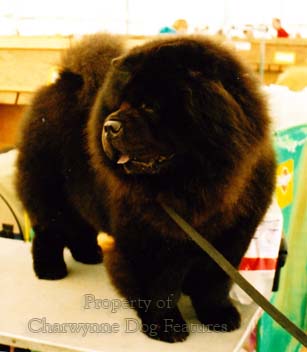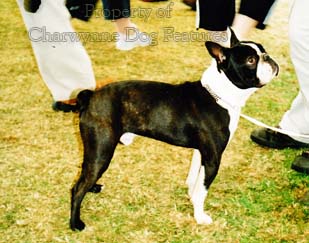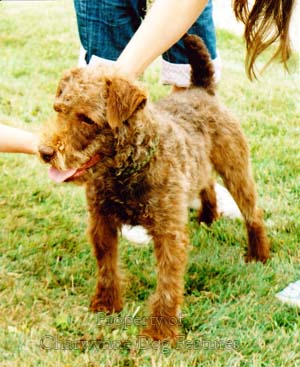445 Breed Differences
MAGNIFYING DIFFERENCES-BREEDING EXAGGERATIONS
by David Hancock
 The head construction is often a decider when identifying breeds; the Braque St Germain looks like our Pointer at first glance, but when you look at the stop and the occiput, then the ear carriage, it is easier to separate them. This is true too of the two recognised ridgeback breeds, a Thai Ridgeback has a different ear carriage from the Rhodesian version, with most of the latter being stronger in build. Closer to home, the Mastiff is expected to be bigger than the Bullmastiff, but at world dog shows it is easy to confuse the two. For me, the contemporary Mastiff has lost its classic head and is too heavy-headed and loose-lipped. But sadly the Bullmastiff is now changing, with the help of show ring judges, from being 60% Mastiff 40% Bulldog to being 75% Bulldog 25% Mastiff, not what the pioneer breeders sought at all. A round-headed stub-nosed dog with a wrinkled forehead contradicts the Bullmastiff standard, but dogs bearing such features are richly rewarded in today's show rings. There should not be such basic differences within a breed, not if breed-identity and breed-type are truly valued.
The head construction is often a decider when identifying breeds; the Braque St Germain looks like our Pointer at first glance, but when you look at the stop and the occiput, then the ear carriage, it is easier to separate them. This is true too of the two recognised ridgeback breeds, a Thai Ridgeback has a different ear carriage from the Rhodesian version, with most of the latter being stronger in build. Closer to home, the Mastiff is expected to be bigger than the Bullmastiff, but at world dog shows it is easy to confuse the two. For me, the contemporary Mastiff has lost its classic head and is too heavy-headed and loose-lipped. But sadly the Bullmastiff is now changing, with the help of show ring judges, from being 60% Mastiff 40% Bulldog to being 75% Bulldog 25% Mastiff, not what the pioneer breeders sought at all. A round-headed stub-nosed dog with a wrinkled forehead contradicts the Bullmastiff standard, but dogs bearing such features are richly rewarded in today's show rings. There should not be such basic differences within a breed, not if breed-identity and breed-type are truly valued.
Small red tan terrier: ears down it's a Norfolk, ears up it's a Norwich; is this the essential criterion for one breed to be identified from another, or just plain pickiness? Here are two admirable breeds separated solely by ear carriage. Is that enough, or, one day when numbers are low or inheritable diseases encountered, will they merge? Horrifying for their devotees, perhaps, but does the general public appreciate such niceties? Does the man in the street know a Welsh Terrier from a Lakeland? Do the dog-owning community, all six million of them, really care about breed differences? 
The first time I saw a Langhaar I thought it was an Irish Setter, but then, it wore the same jacket: a solid rich chestnut, with feathering. I can easily confuse a parti-coloured Langhaar with a Large Munsterlander, but fanciers of those two breeds see them as very different. I can tell an Appenzeller from an Entlebucher, but only when they are side by side. If you put an Australian, Norfolk, Norwich and Lucas Terrier, in the ring with a Portuguese Podengo Pequeno, in the same coat colour, most spectators, as opposed to breed specialists, would have trouble separating them into different breeds, let alone identifying their breeding. It is probably true too that most of the public are not as breed-conscious as those who show dogs.
But has breed-identity prevailed over soundness in some breeds? The parties to the European Convention for the Protection of Pet Animals evidently think so. Their resolution on the breeding of pet animals, adopted by multilateral consultation ten years ago names guilty breeds. They aim to: set maximum and minimum values for height and weight in very large and very small breeds, set maximum values for the proportion between length and height of short-legged dogs (Basset Hounds and Dachshunds) to avoid disorders of the vertebral column, and set limits to exaggerations. The latter include: shortness of the skull, so that breathing difficulties are avoided (citing the Bulldog, Japanese Chin, King Charles Spaniel, Pug and Pekingese), abnormal positions of legs (straight stifles in Chows, Buhunds, Lapphunds), (bowed legs in Basset Hounds, Shih Tzu, Pekingese), very long ears (Cocker Spaniel, Bloodhound, Basset Hound), and markedly folded skin (Bulldog, Basset Hound, Shar Pei, Pug aand Pekingese).
It also seeks to set limits to abnormal size and form of eyes or eyelids (St Bernard, Basset Hound, Bloodhound) and small deep-lying eyes (citing four terrier breeds, Chows, Newfoundlands, etc.), as well as large protruding eyes (Boston Terrier, Cavalier KC Spaniel, Dandie Dinmont, Brussels Griffon, etc.). We supply the largest number of breeds in this list of any country. To concerns about discomfort resulting from exaggerations could be added excessive coat; a number of our breeds, never originally heavy-coated, now increasingly feature too heavy a coat for the dog's good, and quite needlessly. But it's all in the name of the breed, I hear. What that usually means is: it's all in the name of show ring success; if they don't look like that, they don't win. This is no comfort to the dog or most pet owners coping with a discomforted dog.
Breed points (very long ears, very short muzzles, sunken or prominent eyes) can exaggerate themselves as gene dominance exerts itself. This is why judging to the breed standard is so important. Breed points can be exaggerated by breeders to produce a 'kennel signature' and make a mark in their breed. Breed points can be rewarded by sycophantic judges anxious for their next appointment. But it is an inescapable fact that exaggeration can be harmful to the dog. It shouldn't need a watchful European body to tell us that some breeds are being bred to a harmful design, but it is commendable that our KC is responding to this convention although the UK has yet to sign up to it. If breed identity relies on the exaggeration of some features to the distress of the dog, then there is something seriously wrong with that breed. Every breed should look like itself - not a caricature of itself.
Originally function decided form, that is why the flock guardians all look like each other. It is hard to tell an Estrela from a Karst or a Caucasian Owtcharka, or a Tatra Mountain Dog from a Kuvasz. In scenthounds, a red Bloodhound resembles a Redbone Coonhound. In sighthounds, a smooth Saluki looks very much like a Sloughi and an Azawakh. In terriers a leggy Jack Russell is much like a small Fox Terrier. In sporting spaniels, a Field is easily confused with a Sussex. It is easier to separate the two cocker breeds, the American having the deeper stop and more prominent rounding of the skull, the more profuse coat and the downward slope from withers to croup. But these are exaggerations and in time may exaggerate themselves to an undesired degree.
A difference in size marks out the Leonberger from say an Estrela Mountain Dog but it is forgiveable to mix up a Cesky Fousek, a Korthals Griffon, a German wire-haired Pointer and a Stichelhaar. Soon the difference between the Akita and the Great Japanese Dog will have to be noticed; I have only just managed to spot the difference between them and the Hokkaido. The waterdogs take some sorting out; the Spanish, Italian, Dutch, Irish and French breeds being quite similar, again showing the way in which function decided form across Europe. It is forgiveable too to confuse a big grey shaggy-coated lurcher with a Deerhound, or even an Irish Wolfhound. They are all expected to perform the same basic function. Breed differences, as our native terrier breeds show, often came with locality, with variations in each Lake District valley, for instance. But they were never exaggerations. 
The head of the Bullmastiff is one of its main breed points, but it should not, according to its KC-approved breed standard, be Pug-nosed. The breed standard specifies quite precisely that the distance from the nose-tip to the stop must be approximately one-third of the length from the tip of the nose to the centre of the occiput. A shorter muzzle is a breach of the breed standard and an exaggeration. A Bullmastiff has just been made into a champion, by both breed and all-round top judges, with a muzzle which breaches the standard, as well as a degree of wrinkle which also breaches it. A well-known Bullmastiff breeder and judge recently told me that she has both correct and incorrect (i.e. too short) muzzles in her kennel. The dogs with approved muzzle length can run and run; the ones with incorrect muzzles are out of breath all too quickly and suffer in the heat. It is shaming that the European Convention is needed; it is good to know that our KC is starting to act to reduce such distress; too short a muzzle does bestow distress.
I recently attended a game fair on a warm but not hot day; several hundred dogs were present: a Foxhound pack, a Beagle pack, a collection of hunting Bassets for a competition on the flags, gundogs for a scurry, working terriers for a show, racing Whippets and over a hundred visitors' pets. Of all of these dogs only one, an American Bulldog with a short nose, became distressed by the warmth of the day. A decade ago I attended the world dog show in Brussels; a Bulldog collapsed in the ring in the heat and had to receive emergency attention. Within half an hour, it was back in the ring, only to end up in the veterinary room, being given oxygen and covered in ice-cubes. The wretched Bulldog just could not breathe properly through its muzzleless mouth. This is direct cruelty and should be prosecuted. Our KC has recently amended the Bulldog standard to include: 'Dogs showing respiratory distress highly indesirable'. But does every judge know of this? 
At the Neapolitan Mastiff Club's Open Show of the 9th of April 2005, the judge was an extremely knowledgeable very competent Dutch breed specialist. In his critique on the open dog class he wrote: '...over the years I have come across quite a few bad eyes, but some entries managed to make me almost speechless; how is this possible...searching for eyes, which proved to be too small, too deep set and severely damaged.' Did the exhibitor-owners of such dogs themselves have 'severely damaged' eyes which prevented their spotting such a handicap? I think not; but the standard for this breed does actually stipulate eyes that are 'set fairly deep'. That is most unwise and the breed standard, which is owned by the Kennel Club, needs early amendment. No other mastiff breed has such a requirement; this is not a breed difference but a breed disability, and an intolerable one.
Aha, I can hear exhibitors exclaim, if I don't follow the breed standard, how can my dogs win? Any humane fancier would ignore breed points which inflict disabilities, whilst lobbying for such a harmful requirement to be removed without delay. A dog show is a competition between good dogs to decide the relative merits of the entry. That competition should never preclude the best interests of the dogs as well as the breed. Does competition bring out the worst in people? When exhibiting livestock, I found only friendly competitiveness. But sadly I have witnessed a much more aggressive approach in the dog world, reminding me of the account in the Aberdeen Press and Journal, some years ago, which read: "One main event in London was Cruft's Dog Show. For two days dogs and dog owners from all over the country crowded the huge halls and galleries, barking at one another in fierce competition."
But by itself a breed standard is just a start. The standard of the Bloodhound states very clearly 'eyes neither sunken nor prominent' but I see show ring Bloodhounds with sunken eyes. Those in the Bloodhound packs, bred for function, do not feature such a liability. But the same could be said of Basset Hounds too. In Germany there is now a modern term for breeding which imposes cruelty on dogs: 'qualzucht', literally, torture-breeding. Nearly twenty years ago, the Dutch Ministry of Agriculture produced a booklet entitled 'Mooi, Mooier, Mooist' (Beautiful, more beautiful, most beautiful) denouncing progress